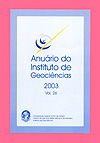Caracterização da contaminação por petróleo e seus derivados na Baía de Guanabara: aplicação de técnicas organogeoquímicas e organopetrográficas
DOI:
https://doi.org/10.11137/2003_0_69-78Abstract
The Guanabara Bay is the second bigger bay of the Brazilian coast. The bay is one of most beautiful of the world and shelters an ample and protected natural environment, preponderant factor for the development of the region. Due the pollution of this ecosystem, today, the bay represents an important focus of environmental interest. In order to determinate the preservation degree of the organic components of bottom sediments from Guanabara Bay, ninety-two samples were collected from these sediments, however, preliminarily, twenty-five samples were analyzed. These twenty-five samples were submitted to techniques of organic geochemistry (Total Organic Carbon - TOC and Rock-Eval pyrolysis) to determinate the amount and quality of the organic matter, and microscopy (transmitted white light and reflected ultraviolet light). The TOC values of the twenty-five samples range from 0.04 to 6.1% indicating the high preservation degree of the organic matter. The Rock- Eval pyrolysis data show Hydrogen Index (HI) values from 25 to 249 mg HC/gCOT; S1 values ranges from 0,02 to 5,6 mg HC/gR; Production Index (PI) rise up 0,5. The results of the microscopy investigation showed that occur a predominance of amorphous organic matte (AOM) over the palynomorphs and phytoclasts. The liptinitic material showed a light yellow-greenish yellow fluorescence color. The percentages of AOM, the TOC values and fluorescence color indicate a high degree of preservation of the organic matter. The integration of the results from organic geochemistry and microscopy techniques indicate that the sediments of the Baía de Guanabara present very high hydrocarbon pollution, deposited in dysoxic-anoxic environment.Downloads
Download data is not yet available.
Downloads
Published
2003-01-01
How to Cite
Mendonça Filho, J. G. (2003) “Caracterização da contaminação por petróleo e seus derivados na Baía de Guanabara: aplicação de técnicas organogeoquímicas e organopetrográficas”, Anuário do Instituto de Geociências. Rio de Janeiro, BR, 26, pp. 69–78. doi: 10.11137/2003_0_69-78.
Issue
Section
Article
License
This journal is licensed under a Creative Commons — Attribution 4.0 International — CC BY 4.0, which permits use, distribution and reproduction in any medium, provided the original work is properly cited.















